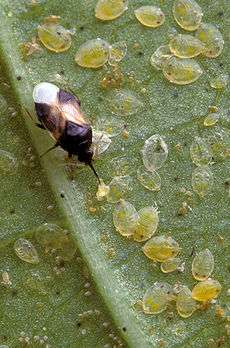Orius
The genus Orius (commonly called minute pirate bug) consists of omnivorous bugs in the family Anthocoridae (pirate bugs). Adults are 2–5 mm long and feed mostly on smaller insects, larva and eggs, such as spider mites, thrips, jumping plant lice,[1] and white fly, but will also feed on pollen and vascular sap.[2]
| Orius | |
|---|---|
 | |
| Orius insidiosus | |
| Scientific classification | |
| Kingdom: | |
| Phylum: | |
| Class: | |
| Order: | |
| Suborder: | |
| Family: | |
| Genus: | Orius Wolff, 1811 |

Bites of Orius sp. after one day
These predators are common in gardens and landscapes. They have a fairly painful bite, but are not venomous.
Some species are raised commercially and sold to growers as a form of biological control.
In laboratory conditions, the larval development of Orius niger takes 14 days at a temperature of 25°; females have a longevity of 60 days and can lay up to 150 eggs.[3]
Species
- Orius candiope Herring, 1966
- Orius diespeter Herring, 1966
- Orius harpocrates Herring, 1966
- Orius insidiosus (Say, 1832) (insidious flower bug)
- Orius minutus (Linnaeus, 1758)
- Orius niger (Wolff, 1811)
- Orius pumilio (Champion, 1900)
- Orius tantillus (Motschulsky)
- Orius thyestes Herring, 1966
- Orius tristicolor (White, 1879)
gollark: Security through obscurity *always* works! RIGHT?!
gollark: Yes.
gollark: > We have not outsourced the client for several reasons, relating to client reliability and other issues. However, we’ve come up with a compromise — we have been developing a plug in architecture to allow people to write open source code that we can plug into our client. Visit the Folding Support Forum to discuss, ask questions, and show off your work.
gollark: Yes, but the *client* isn't open source.
gollark: They seem to be going for a "security through obscurity" thing.
References
- Hérard, Franck (1986). "Annotated list of the entomophagous complex associated with pear psylla, Psylla pyri (L.) (Hom.: Psyllidae) in France" (PDF). Agronomie. 6: 1–34. doi:10.1051/agro:19860101.
- Kiman, Z. B. & Yeargan, K. V. (1985). "Development and reproduction of the predator Orius insidiosus (Hemiptera: Anthocoridae) reared on diets of selected plant material and arthropod prey". Annals of the Entomological Society of America. 78 (4): 464–467. doi:10.1093/aesa/78.4.464.
- Jean-Lou Justine (1978) [Contribution to the study of the influence of alimentation on the development and reproduction of Orius niger Wolff, 1811 (Heteroptera: Anthocoridae)] Contribution à l'étude de l'influence de l'alimentation sur le développement et la reproduction d'Orius niger Wolff, 1811 (Heteroptera : Anthocoridae). Masters Thesis, University of Montpellier, Montpellier, France, 92 pages [in French with English abstract] doi:10.6084/m9.figshare.155299
External links
- Iowa State University Department of Entomology Iowa Insect Information Notes, minute pirate bug entry (with picture)
This article is issued from Wikipedia. The text is licensed under Creative Commons - Attribution - Sharealike. Additional terms may apply for the media files.